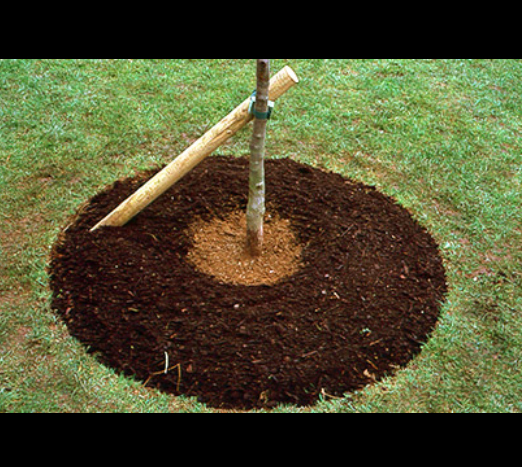
Staking is necessary for any newly planted large tree, including fruit trees and standard shrubs. Smaller trees usually don’t need staking.
When to stake trees
Stake trees as soon as they are planted and replace stakes whenever they fail. Check stakes and ties every year to avoid tight tree ties damaging the stems and to replace any ties that have frayed or broken.
Once the tree can stand unsupported without bending or shifting in the ground, remove the stakes. This usually takes eighteen months to three years, but may be longer for semi-mature trees or ones on weak rootstocks, such as dwarf apple trees.
How to stake trees
There are a number of different staking methods, depending on the type of tree, tree size and method of planting.
All stakes should penetrate the soil to at least 60cm (2ft) deep. If the stake moves in the ground, it will not anchor the plant.
Single stake
This is the standard method for staking bare-root trees, with the stake inserted before planting.
- For most trees: the stake should be one-third of the height of the tree. This anchors the roots and allows the stem to sway and thicken
- For tress with long or flexible stems: use long, vertical stake, cutting it lower in the second year. There should be a gap of 2.5-3cm (about an inch) between the stem and the stake
Stakes should be inserted on the side of the prevailing wind so that the tree is blown away from the stake.
Double stake
This is the standard method of staking container-grown and rootballed trees. Two or three stakes can be inserted opposite each other, or equally spaced around the tree outside the root ball, and secured to the trunk by long ties or a timber crossbar and tie. This method is also useful on windy sites.
Angled stake
An angled stake is used for trees planted on slopes. Drive a stake in before or after planting at a 45 degree angle, leaning into the prevailing wind. Secure with a flexible tree tie.
Guying
Guying is particularly useful for large trees when transplanted. Secure strong wire to low stakes inserted at a 45 degree angle away from the tree. Prevent rubbing by covering the wire with rubber hosepipe where it is wrapped around the stem or branches of the tree.
Using tree ties and ground anchors
Tree ties
Special tree ties are available made of durable, long-lasting plastic, with buckles for fastening and adjustment.
- These ties can be loosened as the tree girth expands
- Use spacers to prevent the stem and stake rubbing against each other
- Make a figure of eight to hold the tree to the stake, with the spacer in between the tree and the stake, and secure the tie to the stake with a nail
In an emergency an old pair of tights can be used as a rough and ready tree tie.
Ground anchors
Ground anchors are essentially underground staking systems. They offer discreet anchorage of the rootball and are particularly useful for specimen trees or those in highly visible areas where above-ground methods would be unsightly. Tree anchors must be fitted at the time of planting. Systems such as the Platipus Tree Anchor and biodegradable tree anchors made from potato starch are available.
